Performance and Nutritional Properties of Einkorn, Emmer and Rivet Wheat in Response to Different Rotational Position and Soil Tillage
Abstract
1. Introduction
2. Materials and Methods
2.1. Field Trials
2.2. Samplings and Assessments
2.3. Quality and Nutritional Characterization
2.4. Statistical Analysis
3. Results and Discussion
3.1. Agro-Ecosystem and Productive Performance in 2015/16 and 2016/17
3.2. Agro-Ecosystem and Productive as Affected by Species, Rotational Position, and Tillage in 2017/18
3.2.1. Canopy Cover During Vegetative Growth Stages
3.2.2. Crop Height at Maturity
3.2.3. Foliar Diseases Severity
3.2.4. Ear Density and Grain Yield
3.3. Quality and Nutritional Performance as Affected by Species, Rotational Position, and Tillage in 2017/18
3.3.1. Nutritional Content
3.3.2. Phenolics Content and Antioxidant Activities
3.4. Within-Species Patterns
3.4.1. Einkorn
3.4.2. Emmer
3.4.3. Rivet
4. Conclusions
Supplementary Materials
Author Contributions
Funding
Acknowledgments
Conflicts of Interest
References
- Massawe, F.; Mayes, S.; Cheng, A. Crop Diversity: An Unexploited Treasure Trove for Food Security. Trends Plant Sci. 2016, 21, 365–368. [Google Scholar] [CrossRef] [PubMed]
- Friedrich, C.; Longin, H. Back to the Future—Tapping into Ancient Grains for Food Diversity. Trends Plant Sci. 2016, 21, 731–737. [Google Scholar]
- Serpolay, E.; Dawson, J.C.; Chable, V.; Lammerts Van Bueren, E.; Osman, A.; Pino, S.; Silveri, D.; Goldringer, I. Diversity of different farmer and modern wheat varieties cultivated in contrasting organic farming conditions in western Europe and implications for European seed and variety legislation. Org. Agric. 2017, 1, 127–145. [Google Scholar] [CrossRef]
- Padulosi, S.; Hoeschle-Zeledon, I. Underutilized plant species: What are they? Leisa Leusden 2004, 20, 5–6. [Google Scholar]
- Shewry, P.R. Do ancient types of wheat have health benefits compared with modern bread wheat? J. Cereal Sci. 2018, 79, 469–476. [Google Scholar] [CrossRef] [PubMed]
- Molberg, Ø.; Uhlen, A.K.; Jensen, T.; Flæte, N.S.; Fleckenstein, B.; Arentz–Hansen, H.; Raki, M.; Lundin, K.E.A.; Sollid, L.M. Mapping of gluten T-cell epitopes in the bread wheat ancestors: Implications for celiac disease. Gastroenterology 2005, 128, 393–401. [Google Scholar] [CrossRef]
- Dinu, M.; Whittaker, A.; Pagliaia, G.; Benedettelli, S.; Sofi, F. Ancient wheat species and human health: Biochemical and clinical implications. J. Nutr. Biochem. 2018, 52, 1–9. [Google Scholar] [CrossRef]
- Sacchi, G.; Cei, L.; Stefani, G.; Lombardi, G.V.; Rocchi, B.; Belletti, G.; Padel, S.; Sellars, A.; Gagliardi, E.; Nocella, G.; et al. A Multi-Actor Literature Review on Alternative and Sustainable Food Systems for the Promotion of Cereal Biodiversity. Agriculture 2018, 8, 173. [Google Scholar] [CrossRef]
- Wolfe, M.S.; Baresel, J.; Desclaux, D.; Goldringer, I.; Hoad, S.; Kovacs, G.; Löschenberger, F.; Miedaner, T.; Østergård, H.; Lammerts van Bueren, E. Developments in breeding cereals for organic agriculture. Euphytica 2008, 163, 323–346. [Google Scholar] [CrossRef]
- Milach, S.C.K.; Federizzi, L.C. Dwarfing genes in plant improvement. Adv. Agron. 2001, 73, 35–63. [Google Scholar]
- Guarda, G.; Padovan, S.; Delogu, G. Grain yield, nitrogen-use efficiency and baking quality of old and modern Italian bread-wheat cultivars grown at different nitrogen levels. Eur. J. Agron. 2004, 21, 181–192. [Google Scholar] [CrossRef]
- Stagnari, F.; Onofri, A.; Codianni, P.; Pisante, M. Durum wheat varieties in N-deficient environments and organic farming: A comparison of yield, quality and stability performances. Plant Breed. 2013, 132, 266–275. [Google Scholar] [CrossRef]
- Cooper, J.; Baranski, M.; Stewart, G.; Nobel-de Lange, M.; Bàrberi, P.; Fließbach, A.; Peigné, J.; Berner, A.; Brock, C.; Casagrande, M.; et al. Shallow non-inversion tillage in organic farming maintains crop yields and increases soil C stocks: A meta-analysis. Agron. Sustain. Dev. 2016, 36, 1–20. [Google Scholar] [CrossRef]
- Zaharieva, M.; Monneveux, P. Cultivated einkorn wheat (Triticum monococcum L. subsp. monococcum): The long life of a founder crop of agriculture. Genet. Resour. Crop Evol. 2014, 61, 677–706. [Google Scholar]
- Zaharieva, M.; Ayana, N.G.; Hakimi, A.A.; Misra, S.C.; Monneveux, P. Cultivated emmer wheat (Triticum dicoccon Schrank), an old crop with promising future: A review. Genet. Resour. Crop Evol. 2007, 57, 937–962. [Google Scholar] [CrossRef]
- Zeven, A.C. Classification of landraces and improved cultivars of rivet wheat (Triticum turgidum) and bread wheat (T. aestivum) from Great Britain and described in 1934. Euphytica 1990, 47, 249–258. [Google Scholar]
- Sellars, A.; Trump, A.; Growing organic Spelt and ensuring a market. Cerere Practice Abstract #7. November 2018. Available online: www.cerere2020.eu (accessed on 15 October 2019).
- Park, E.Y.; Baik, B.; Machado, S.; Gollany, H.T.; Fuers, E.P. Functional and Nutritional Characteristics of Soft Wheat Grown in No-Till and Conventional Cropping Systems. Cereal Chem. 2015, 92, 332–338. [Google Scholar] [CrossRef]
- SOLIBAM Project. Progress Report from all WP3 partners on 3.1, 3.2 and 3.3 from trial work completed up to M39, Including Initial Results and Review of Progress of Tasks. Deliverable 3.3. EU FP7 SOLIBAM (Strategies for Organic and Low-Input Integrated Breeding and Management) Project, FP7- KBBE-245058. 2014. Available online: www.solibam.eu (accessed on 15 October 2019).
- Meier, U. Growth Stages of Mono- and Dicotyledonous Plants. BBCH Monograph; Julius Kühn-Institut: Quedlinburg, Germany, 2001. [Google Scholar] [CrossRef]
- AOAC. Approved Methods of Association of Official Analytical Chemists, 5th ed.; AOAC: Arlington, VA, USA, 1990. [Google Scholar]
- Prosky, L.; Asp, N.G.; Scheweizer, T.F.; de Vries, J.W.; Furda, I. Determination of insoluble, soluble, and total dietary fiber in foods and food products: Interlaboratory study. J. Assoc. Off. Anal. Chem. 1988, 71, 1017–1023. [Google Scholar]
- Dinelli, G.; Segura-Carretero, A.; Di Silvestro, R.; Marotti, I.; Fu, S.; Benedettelli, S.; Ghiselli, L.; Fernandez-Gutierrez, A. Profiles of phenolic compounds in modern and old common wheat varieties determined by liquid chromatography coupled with time-of-flight mass spectrometry. J. Chromatogr. A 2011, 1218, 7670–7681. [Google Scholar] [CrossRef]
- Singleton, V.L.; Orthofer, R.; Lamuela–Raventos, R.M. Analysis of total phenols and other oxidation substrates and antioxidants by means of Folin–Ciocalteu reagent. Methods Enzym. 1999, 299, 152–178. [Google Scholar]
- Brand-Williams, W.; Cuvelier, H.E.; Berset, C. Use of a free radical method to evaluate antioxidant activity. Food Sci. Technol. 1995, 28, 25–30. [Google Scholar] [CrossRef]
- Benzie, I.F.F.; Strain, J.J. Ferric Reducing Ability of Plasma (FRAP) as a Measure of “Antioxidant Power”: The FRAP Assay. Anal. Biochem. 1996, 239, 70–76. [Google Scholar] [CrossRef] [PubMed]
- R Core Team. A Language and Environment for Statistical Computing; R Foundation for Statistical Computing: Vienna, Austria, 2017; Available online: https://www.R-project.org/ (accessed on 15 October 2019).
- De Mendiburu, F.; Package ‘Agricolae’. CRAN R Project. 2019. Available online: https://cran.r-project.org/web/packages/agricolae/agricolae.pdf (accessed on 15 October 2019).
- Bates, D.M.; Maechler, M.; Bolker, B.; Walker, S.C. Fitting Linear Mixed-Effects Models Using lme4. J. Stat. Softw. 2015, 67. [Google Scholar] [CrossRef]
- Length, R.; Singmann, H.; Love, J.; Buerkner, P.; Herv, M.; Package ‘emmeans’. CRAN R Project. 2019. Available online: https://cran.r-project.org/web/packages/emmeans/emmeans.pdf (accessed on 15 October 2019).
- Kassambara, A.; Mundt, F. factoextra: Extract and Visualize the Results of Multivariate Data Analyses. 2017. Available online: https://cran.r-project.org/web/packages/factoextra/index.html (accessed on 15 October 2019).
- Agenbag, G.A. Growth, yield and grain protein content of wheat (Triticum aestivum L.) in response to nitrogen fertiliser rates, crop rotation and soil tillage. S. Afr. J. Plant Soil 2012, 29. [Google Scholar] [CrossRef]
- Bilalis, D.; Karkanis, A.; Patsial, S.; Agriogianni, M.; Konstantas, A.; Triantafyllidis, V. Performance of Wheat Varieties (Triticum aestivum L.) under Conservation Tillage Practices in Organic Agriculture. Not. Bot. Horti Agrobot. 2011, 39, 28–33. [Google Scholar] [CrossRef]
- Woźniak, A. Effect of Crop Rotation and Cereal Monoculture on the Yield and Quality of Winter Wheat Grain and on Crop Infestation with Weeds and Soil Properties. Int. J. Plant Prod. 2019, 13, 177–182. [Google Scholar] [CrossRef]
- Dinelli, G.; Di Silvestro, R.; Marotti, I.; Bosi, S.; Bregola, V.; Di Loreto, A.; Nipoti, P.; Prodi, A.; Catizone, P. Agronomic traits and deoxynivalenol contamination of two tetraploid wheat species (Triticum turgidum spp. durum, Triticum turgidum spp. turanicum) grown strictly under low input conditions. Ital. J. Agron. 2014, 9, 127–135. [Google Scholar] [CrossRef]
- Angus, J.F.; Kirkegaard, J.A.; Hunt, J.R.; Ryan, M.H.; Ohlander, L.; Peoples, M.B. Break crop and rotation for wheats. Crop Pasture Sci. 2015, 66, 523–552. [Google Scholar] [CrossRef]
- Huang, L.; Feng, L.; He, Y.; Tang, Z.; He, J.; Sela, H.; Krugman, T.; Fahima, I.; Liu, D.; Wu, B. Variation in Stripe Rust Resistance and Morphological Traits in Wild Emmer Wheat Populations. Agronomy 2019, 9, 44. [Google Scholar] [CrossRef]
- Hidalgo, A.; Brandolini, A.; Pompei, C. Kinetics of tocols degradation during the storage of einkorn (Triticum monococcum L. ssp. monococcum) and breadwheat (Triticum aestivum L. ssp. aestivum) flours. Food Chem. 2009, 116, 821–827. [Google Scholar]
- Dhanavath, S.; Rao, U.J.S.P. Nutritional and Nutraceutical Properties of Triticum dicoccum Wheat and Its Health Benefits: An Overview. J. Food Sci. 2017, 82, 2243–2250. [Google Scholar] [CrossRef] [PubMed]
- Di Silvestro, R.; Din Loreto, A.; Bosi, S.; Bregola, V.; Marotti, I.; Benedettelli, S.; Segura-Carretero, A.; Dinelli, G. Environment and genotype effects on antioxidant properties of organically grown wheat varieties: A 3-year study. J. Sci Food Agric. 2016. [Google Scholar] [CrossRef] [PubMed]
- Kravchenko, A.N.; Snapp, S.S.; Robertson, G.P. Field-scale experiments reveal persistent yield gaps in low-input and organic cropping systems. Proc. Natl. Acad. Sci. USA 2017, 114, 921. [Google Scholar] [CrossRef] [PubMed]
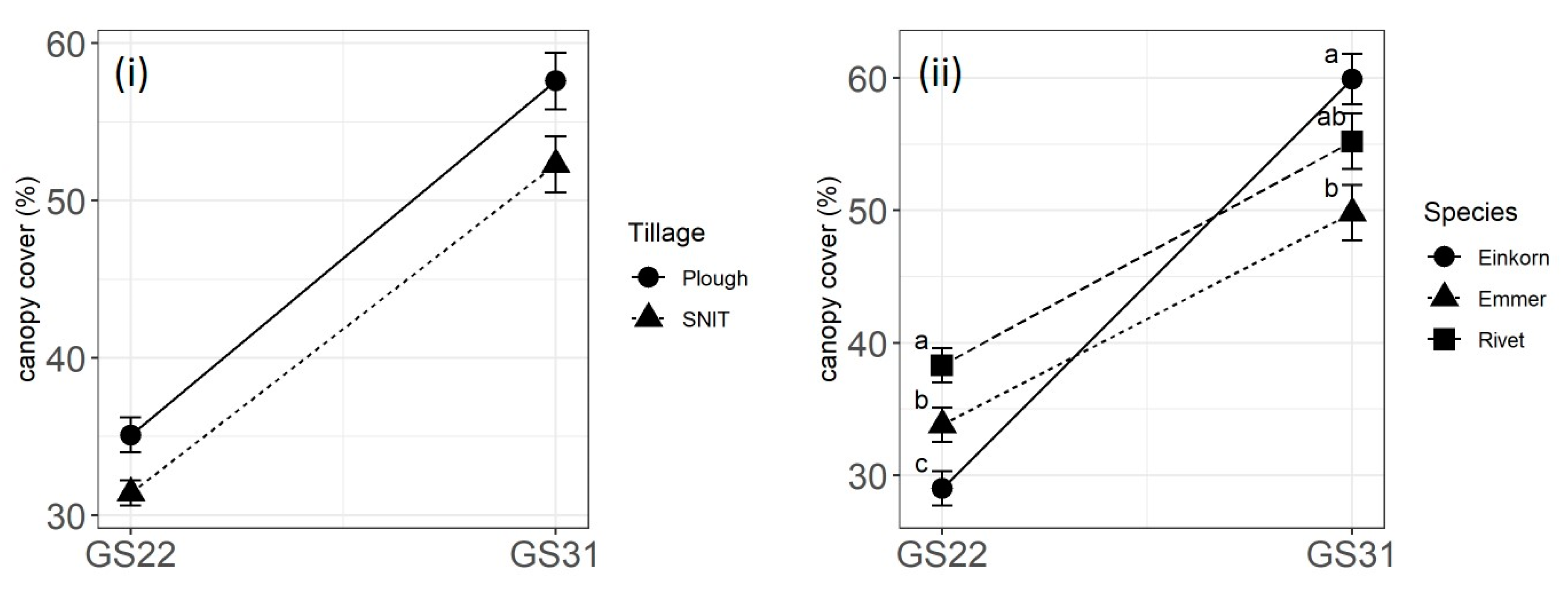
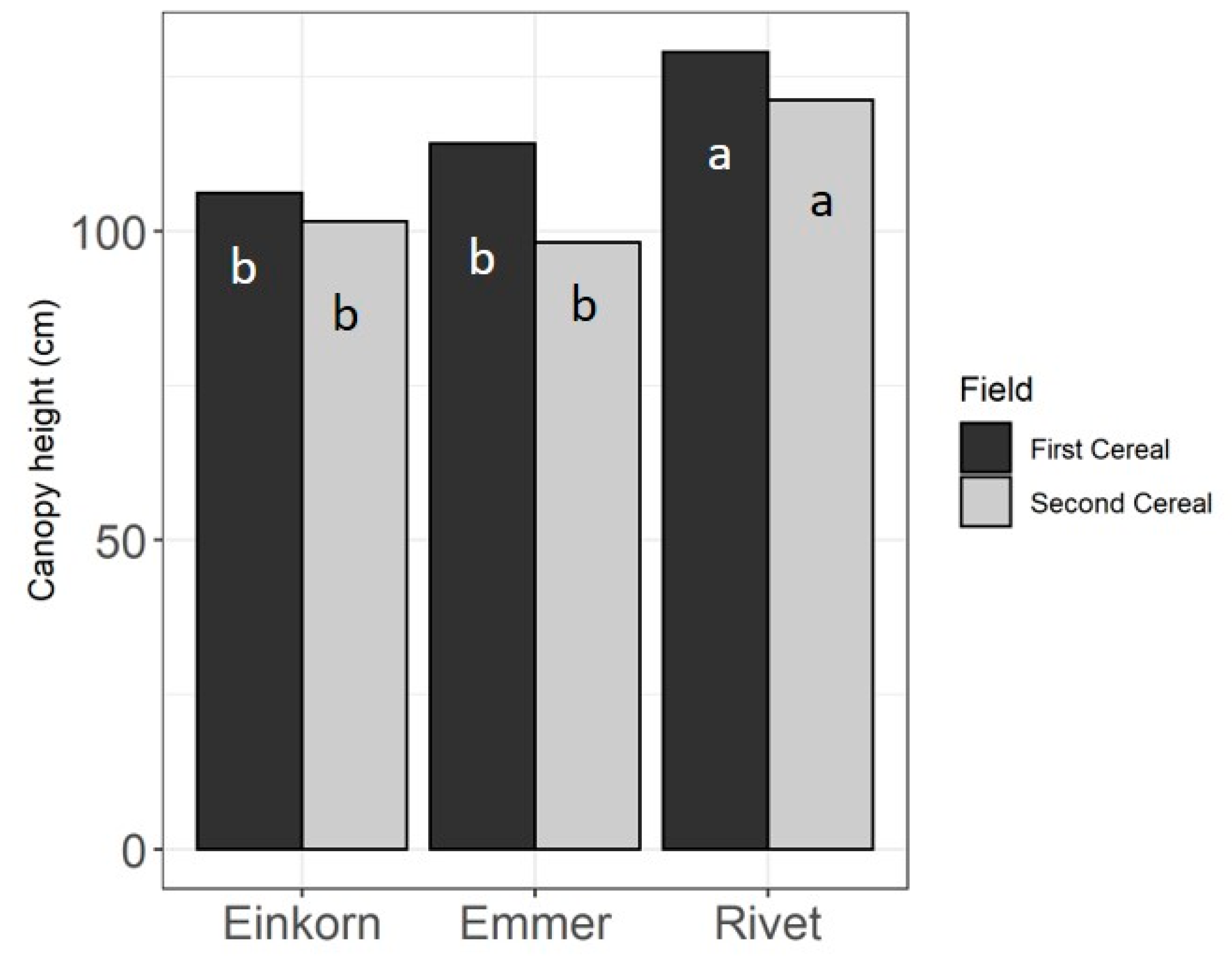
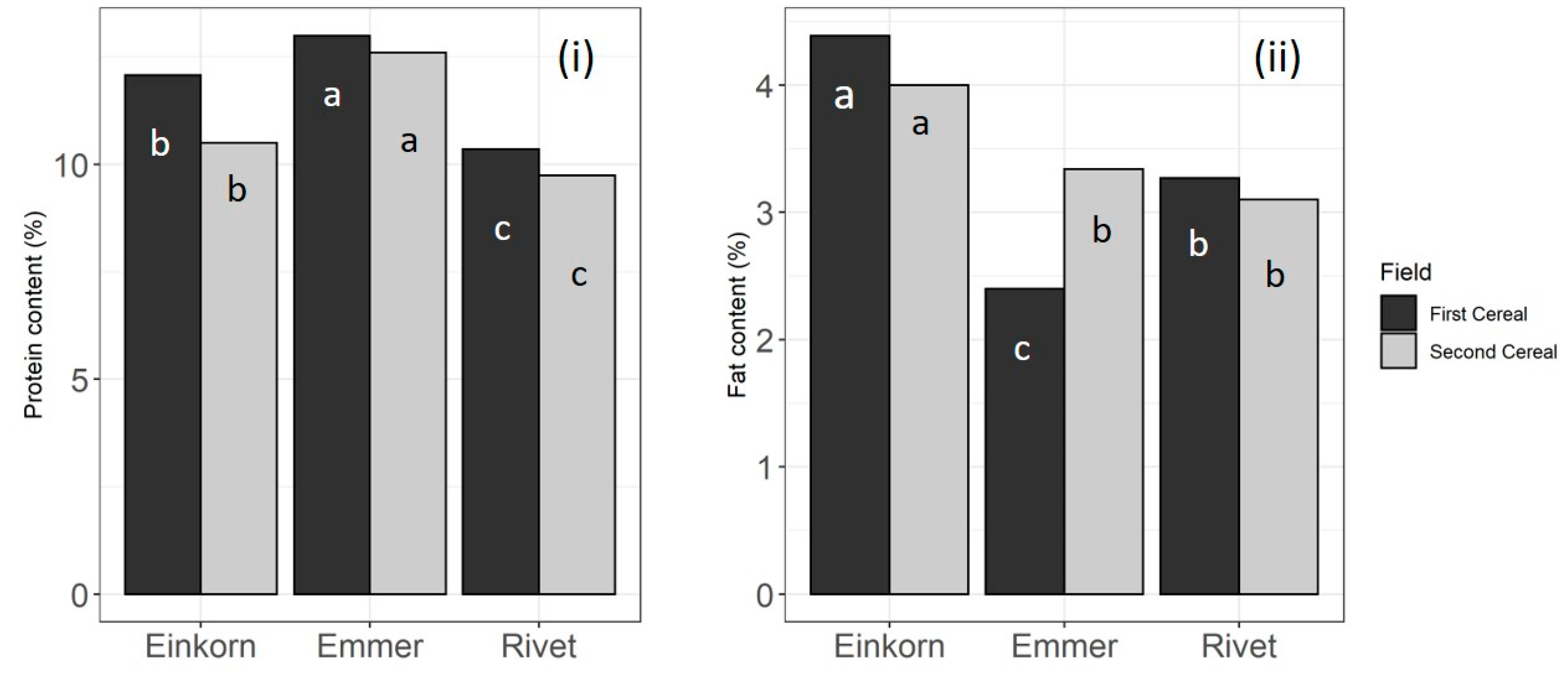
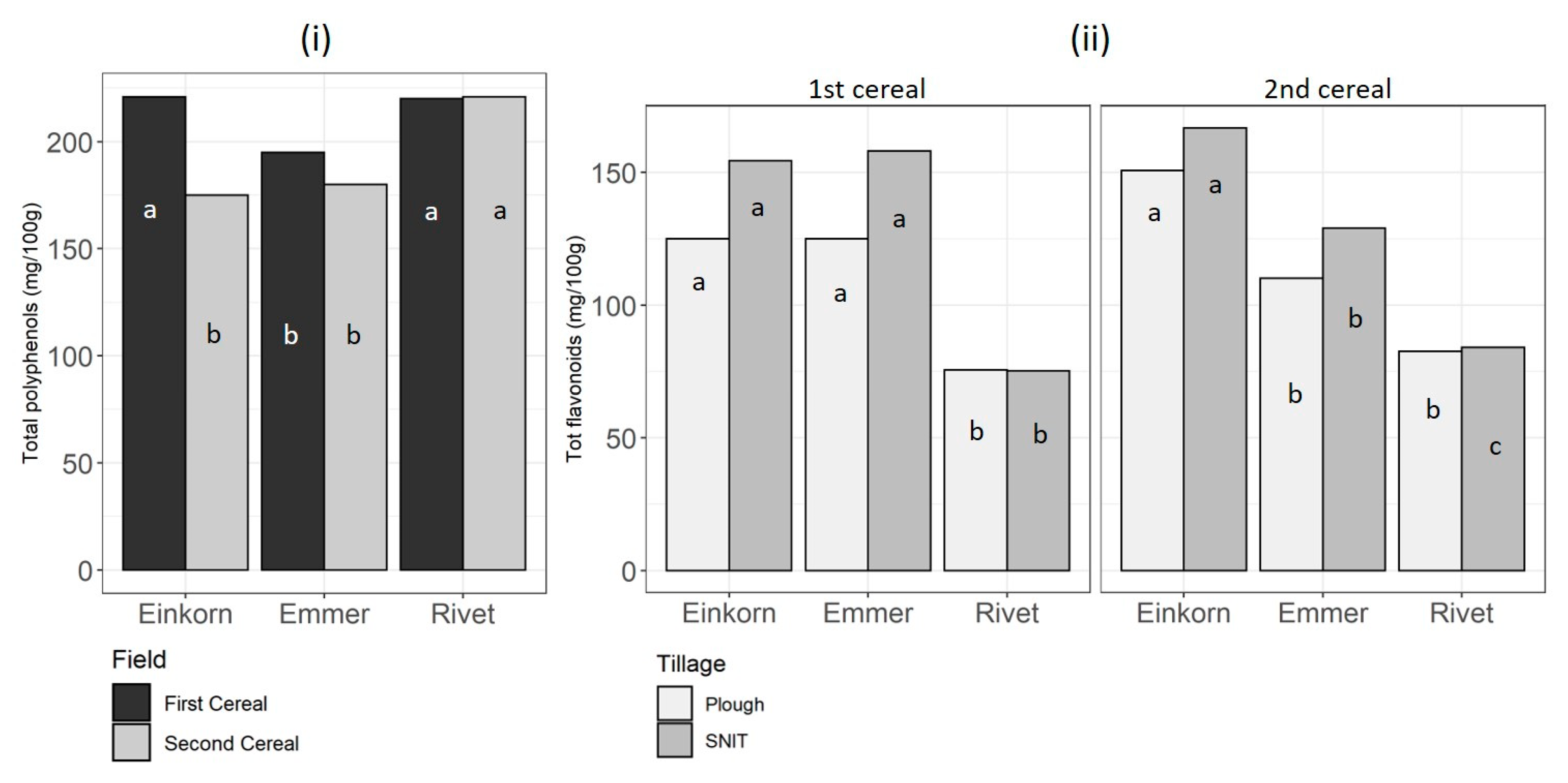
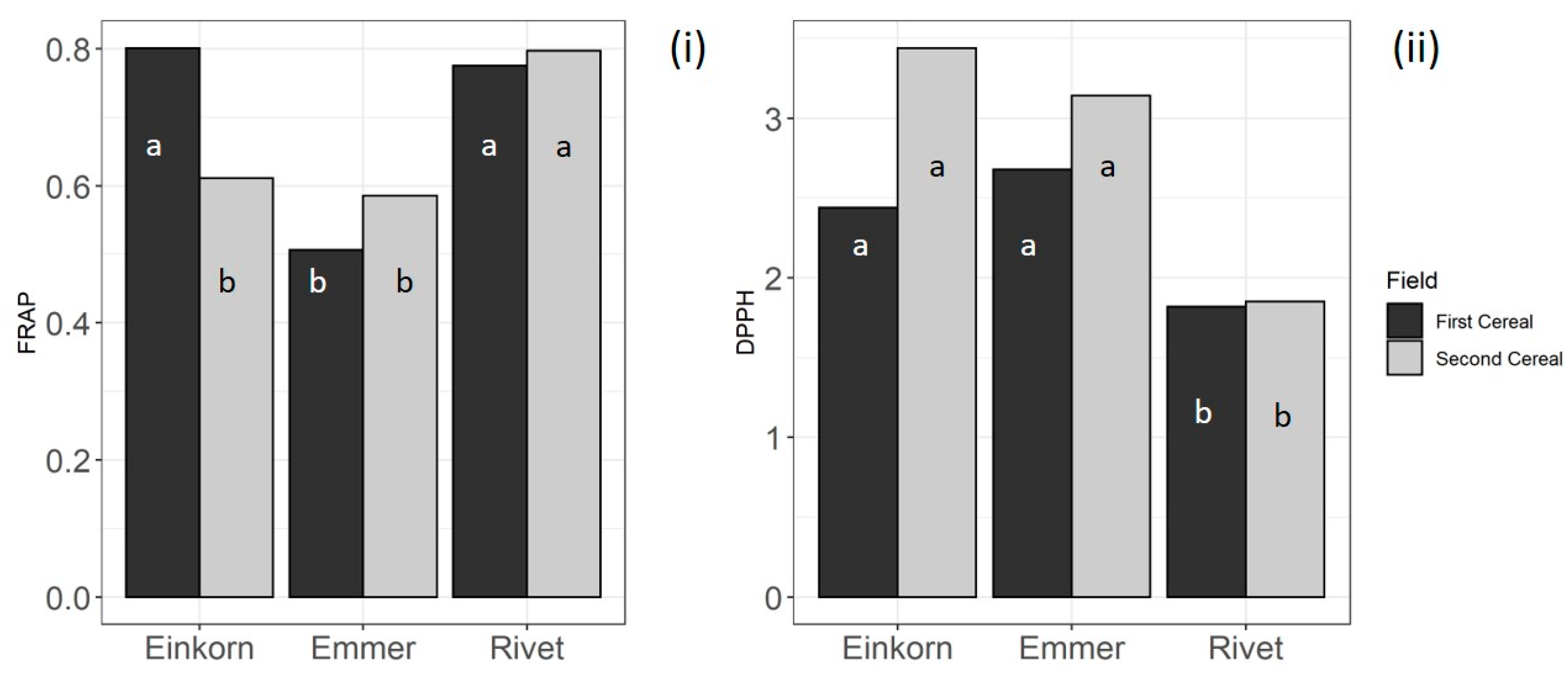
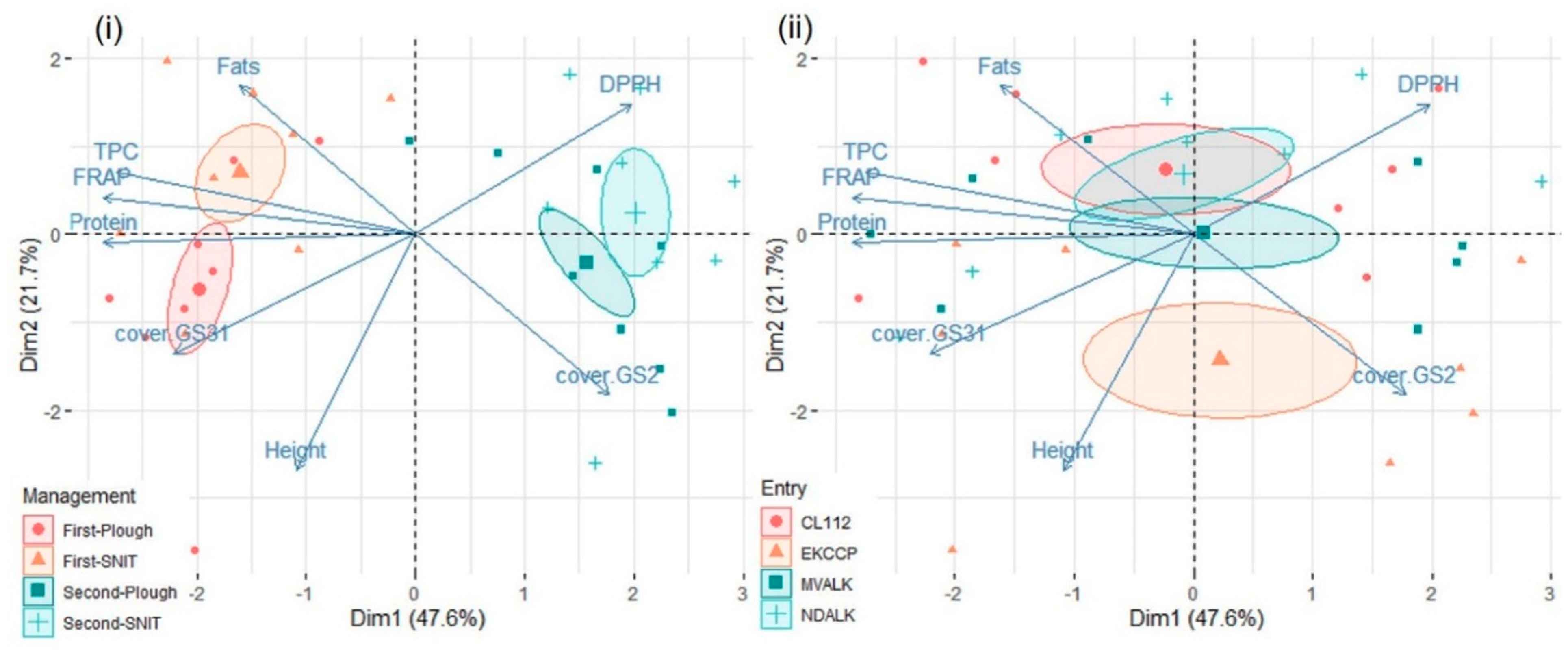
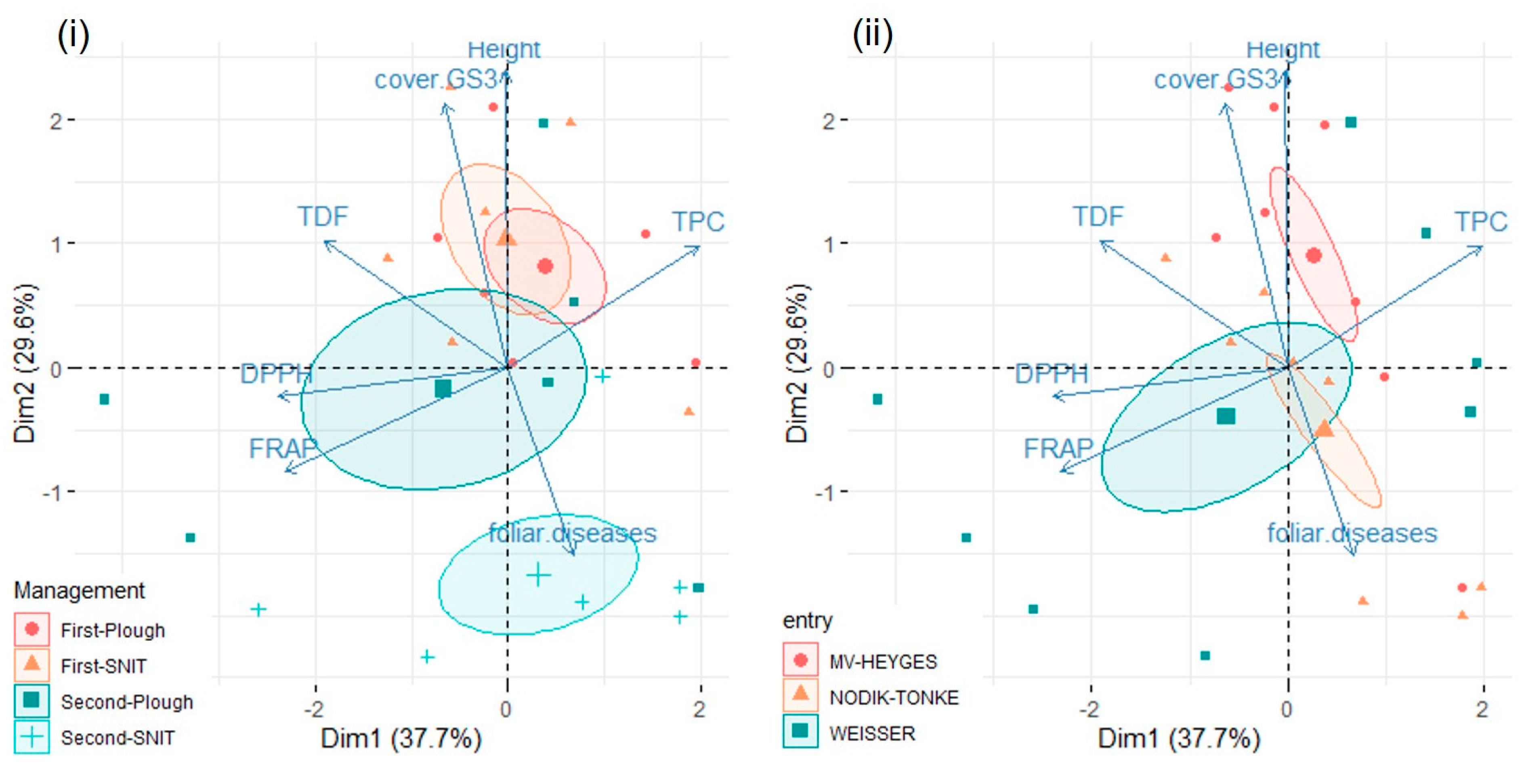
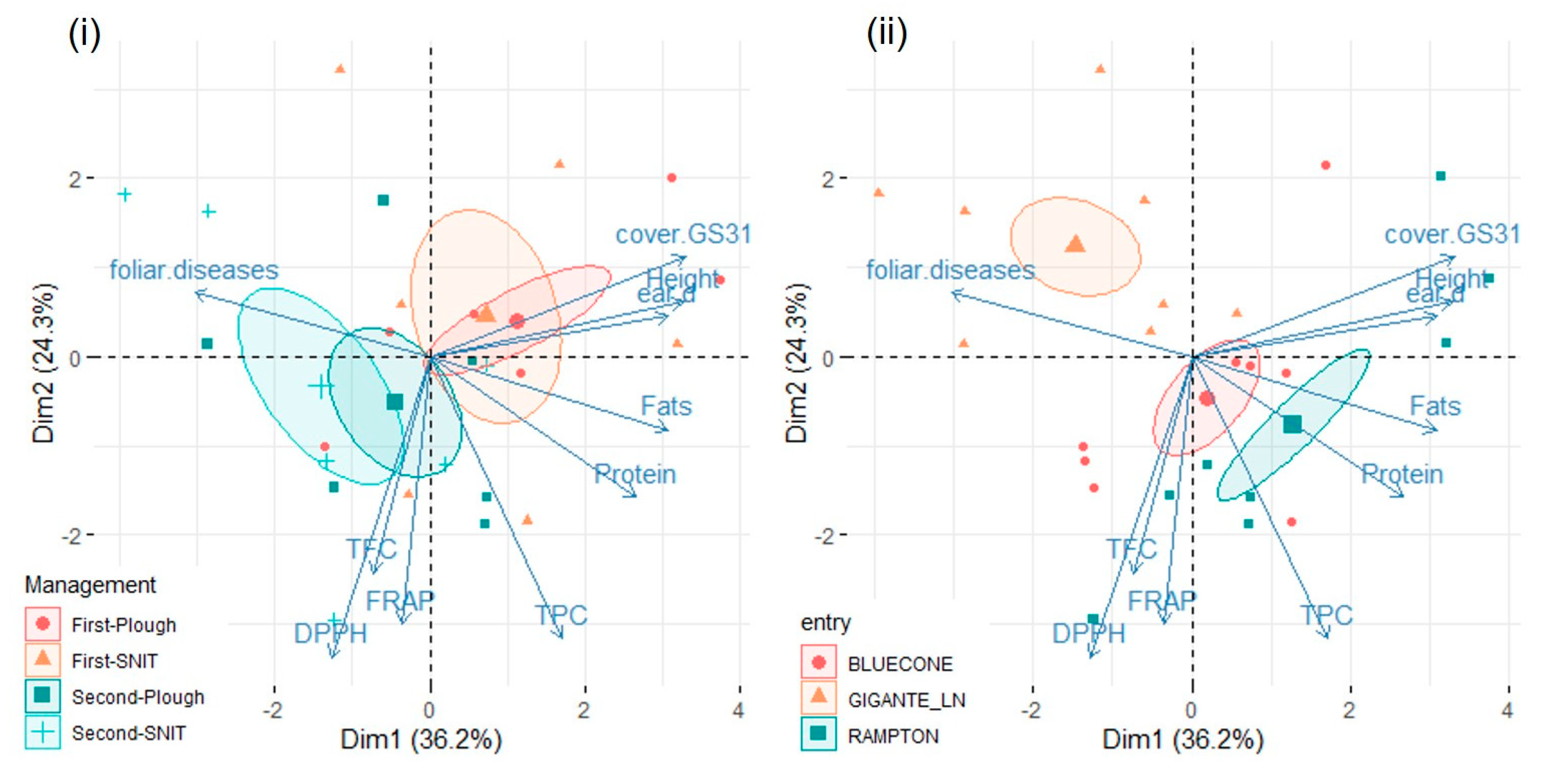
| Entry Name | Origin of the Seed Used in the Trials | Further Information |
|---|---|---|
| Einkorn (Triticum monococcum ssp. monococcum) | ||
| Col 122 | Saved seed from Wakelyns Agroforestry farm, United Kingdom | Line selected from the Einkorn CCP as part of the FP7 SOLIBAM EU project (2010–2015) [19] |
| Einkorn CCP | Saved seed from Wakelyns Agroforestry farm, Fressingfield, Eye IP21 5SD, Suffolk, United Kingdom | Composite cross population originated from crossing seven lines and reproduced organically in Wakelyns Agroforestry since 2011/2012 as part of the FP7 SOILBAM EU Project (2010–2015) [19] |
| Mv Alkor | Hungarian Academy of Science | Commercial, organically bred Hungarian pure line einkorn variety for brewing |
| Mv Menket | Hungarian Academy of Science | Commercial Hungarian short-strawed einkorn variety for brewing. Not included in 2017/18 |
| Nödik Alakor | Nödik Centre for Plant Diversity (Hungary) | Landrace of German origin |
| Emmer (Triticum turgidum ssp. dicoccum) | ||
| Mv Heyges | Hungarian Academy of Science | Commercial, organically bred Hungarian pure line emmer variety |
| Nödik Tonke | Nödik Centre for Plant Diversity (Hungary) | Landrace of Moroccan origin |
| Weisser | Pro Specie Rara (Switzerland) | Spring cultivar originally from France, kept at the ProSpecieRara seed bank under entry code AZ-1971—prospecierara.ch/pflanzen/sortenfinder/ |
| Rivet wheat (Triticum turgidum ssp. turgidum) | ||
| Gigante Lampiño de Najera | Institut Technique de l’Agriculture Biologique (ITAB), France | Traditional cultivar from la Rioja province, Spain, kept at the INIA genebank under entry code BGE013089—webx.inia.es/web_coleccionescrf/PasaporteCRF.asp |
| Percival’s Blue Cone | Saved seed from Wakelyns Agroforestry farm, United Kingdom | Single-ear selection from a traditional English landrace, kept at the John Innes Centre Genetic Resources Unit (GRU) with a store code W1022—seedstor.ac.uk/search-infoaccession.php?idPlant=14581 |
| Rampton’s Rivet | Saved seed from Wakelyns Agroforestry farm, United Kingdom | English selection, kept at the John Innes Centre Genetic Resources Unit (GRU) with store code W0508—seedstor.ac.uk/search-infoaccession.php?idPlant=14092 |
| Cover at BBCH GS31 | Foliar Diseases Severity | Height | Ear Density | Grain Yield | |
|---|---|---|---|---|---|
| Einkorn | % | % | cm | ears/m2 | t/ha |
| 2015/16 | |||||
| mean | 47 ± 3 | 1.4 ± 0.1 | 90.9 ± 3.2 | 349.6 ± 24.3 | 1.28 ± 0.11 |
| entry effect | F = 17.9 (4;15) | F = 1.89 (4;15) | F = 48.39 (4;15) | F = 5.05 (4;15) | F = 9.26 (4;15) |
| p = 1.36 × 10−5*** | p = 0.163 | p = 2.12 × 10−8*** | p = 0.0089** | p = 0.0006*** | |
| 2016/17 | |||||
| mean | 27 ± 3 | 6.0 ± 1.1 | 114.9 ± 4.6 | 400.4 ± 29.5 | 3.13 ± 0.17 |
| entry effect | F = 0.57 (4;10) | F = 18.2 (4;10) | F = 344 (4;10) | F = 0.51 (4;10) | F = 3.31 (4;10) |
| p = 0.687 | p = 0.0001*** | p = 1.17 × 10−10*** | p = 0.732 | p = 0.0569* | |
| Emmer | |||||
| 2015/16 | |||||
| mean | 31 ± 2 | 35.4 ± 2.0 | 93.92 ± 2.33 | 147.4 ± 12.0 | 0.59 ± 0.04 |
| entry effect | F = 5.664 (2;7) | F = 0.129 (2;7) | F = 1.10 (2;7) | F = 0.982 (2;7) | F = 1.078 (2;7) |
| p = 0.034* | p = 0.881 | p = 0.384 | p = 0.421 | p = 0.391 | |
| 2016/17 | |||||
| mean | 46 ± 1 | 16.5 ± 3.3 | 129.5 ± 1.45 | 220.4 ± 17.1 | 2.23 ± 0.24 |
| entry effect | F = 0.1 (2;6) | F = 7.098 (2;6) | F = 9.995 (2;6) | F = 3.424 (2;6) | F = 2.438 (2;6) |
| p = 0.906 | p = 0.0262* | p = 0.0123* | p = 0.102 | p = 0.168 | |
| Rivet | |||||
| 2015/16 | |||||
| mean | 35 ± 5 | 6.0 ± 0.8 | 94.7 ± 9.1 | n.a. | 0.67 ± 0.13 |
| entry effect | F = 19.05 (2;4) | F = 0.581 (2;4) | F = 24.87 (2;4) | n.a. | F = 2.249 (2;4) |
| p = 0.009** | p = 0.601 | p = 0.0055** | n.a. | p = 0.222 | |
| 2016/17 | |||||
| mean | 59 ± 4 | 2.6 ± 0.2 | 137.3 ± 1.9 | 206.7 ± 17.7 | 2.91 ± 0.30 |
| entry effect | F = 1.25 (2;6) | F = 6.868 (2;6) | F = 1.729 (2;6) | F = 2.375 (2;6) | F = 1.896 (2;6) |
| p = 0.352 | p = 0.0281* | p = 0.255 | p = 0.174 | p = 0.230 |
| Variable | Field | Tillage | Species | Field-by-Species | Tillage-by-Species | |
|---|---|---|---|---|---|---|
| (df) | (1) | (1) | (2) | (2) | (2) | |
| Cover at BBCH GS22 | X2 | 0.5203 | 3.5203 | 23.036 | 3.607 | 1.401 |
| p-value | 0.471 | 0.0605(*) | 9.95 × 10−6*** | 0.1648 | 0.496 | |
| Cover at BBCH GS31 | X2 | 7.528 | 3.329 | 12.389 | 4.9781 | 4.623 |
| p-value | 0.0061** | 0.0681(*) | 0.002*** | 0.083* | 0.1 | |
| Height at maturity | X2 | 3.9974 | 1.795 | 41.7405 | 6.5217 | 0.2107 |
| p-value | 0.0456* | 0.1804 | 8.63 × 10−10*** | 0.0384* | 0.8999 | |
| Ear density | X2 | 2.633 | 0.9801 | 32.7457 | 4.1692 | 1.4919 |
| p-value | 0.1046 | 0.3222 | 7.75 × 10−8*** | 0.1244 | 0.4743 | |
| Leaf severity (sqrt transf.) | X2 | 3.012 | 0.099 | 55.774 | 3.797 | 3.448 |
| p-value | 0.0825 | 0.7531 | 7.74 × 10−13*** | 0.1498 | 0.1784 | |
| Grain Yield | X2 | 3.8355 | 1.128 | 6.8068 | 0.919 | 1.9386 |
| p-value | 0.0502(*) | 0.288 | 0.03326* | 0.632 | 0.3794 |
| Variable | Field | Tillage | Species | Field-By-Species | Tillage-By-Species | |
|---|---|---|---|---|---|---|
| (df) | (1) | (1) | (2) | (2) | (2) | |
| Protein content | X2 | 2.4655 | 0.4155 | 59.1097 | 15.88 | 3.965 |
| p-value | 0.1164 | 0.5192 | 1.46 × 10−13*** | 0.0004*** | 0.1377 | |
| Total dietary fiber | X2 | 4.8058 | 0.0958 | 0.7725 | 0.6605 | 1.162 |
| p-value | 0.0284* | 0.7569 | 0.6796 | 0.7188 | 0.5593 | |
| Fat content (sqrt transf.) | X2 | 0.1521 | 0.0945 | 35.4354 | 26.753 | 2.4797 |
| p-value | 0.6965 | 0.7586 | 2.02 × 10−8*** | 1.55 × 10−6*** | 0.2894 | |
| Total polyphenols | X2 | 7.2815 | 0.1921 | 22.5078 | 23.66 | 0.6434 |
| p-value | 0.007** | 0.6603 | 1.30 × 10−5*** | 7.28 × 10−6*** | 0.7249 | |
| Total flavonoids | X2 | 0.0545 | 1.4 | 56.854 | 14.9514 | 6.7078 |
| p-value | 0.815 | 0.2359 | 4.51 × 10−13*** | 0.0006*** | 0.0349* | |
| FRAP | X2 | 0.6548 | 0.0012 | 29.2063 | 26.494 | 2.4665 |
| p-value | 0.4184 | 0.97 | 4.54 × 10−7*** | 1.77 × 10−6*** | 0.2913 | |
| DPPH | X2 | 3.9132 | 0.237 | 3.5.3964 | 12.7107 | 1.2426 |
| p-value | 0.0479* | 0.626 | 2.06 × 10−8*** | 0.0017** | 0.5373 |
© 2019 by the authors. Licensee MDPI, Basel, Switzerland. This article is an open access article distributed under the terms and conditions of the Creative Commons Attribution (CC BY) license (http://creativecommons.org/licenses/by/4.0/).
Share and Cite
Costanzo, A.; Amos, D.C.; Dinelli, G.; Sferrazza, R.E.; Accorsi, G.; Negri, L.; Bosi, S. Performance and Nutritional Properties of Einkorn, Emmer and Rivet Wheat in Response to Different Rotational Position and Soil Tillage. Sustainability 2019, 11, 6304. https://doi.org/10.3390/su11226304
Costanzo A, Amos DC, Dinelli G, Sferrazza RE, Accorsi G, Negri L, Bosi S. Performance and Nutritional Properties of Einkorn, Emmer and Rivet Wheat in Response to Different Rotational Position and Soil Tillage. Sustainability. 2019; 11(22):6304. https://doi.org/10.3390/su11226304
Chicago/Turabian StyleCostanzo, Ambrogio, Dominic C. Amos, Giovanni Dinelli, Rocco E. Sferrazza, Giacomo Accorsi, Lorenzo Negri, and Sara Bosi. 2019. "Performance and Nutritional Properties of Einkorn, Emmer and Rivet Wheat in Response to Different Rotational Position and Soil Tillage" Sustainability 11, no. 22: 6304. https://doi.org/10.3390/su11226304
APA StyleCostanzo, A., Amos, D. C., Dinelli, G., Sferrazza, R. E., Accorsi, G., Negri, L., & Bosi, S. (2019). Performance and Nutritional Properties of Einkorn, Emmer and Rivet Wheat in Response to Different Rotational Position and Soil Tillage. Sustainability, 11(22), 6304. https://doi.org/10.3390/su11226304








